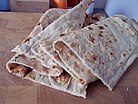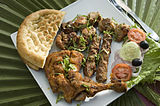North Indian cornmeal flatbread
Makki ki roti Makki ki roti |
| Alternative names | Makyachi Bhaakri in Marathi,
Mokkajonna Rottelu in Telugu,
Makai No Rotlo in Gujarati, Makki di roti/toudaa in Punjabi[1]
Makai ko Roti in Nepali |
|---|
| Type | Bread |
|---|
| Place of origin | Indian subcontinent |
|---|
| Region or state | Jammu, Himachal Pradesh, Punjab, Haryana, Rajasthan, Gujarat, Uttarakhand, and Uttar Pradesh |
|---|
| Main ingredients | Corn flour |
|---|
|
Makki ki roti is a flat unleavened bread made from corn meal (maize flour),[2] primarily eaten in Pakistan, the Jammu region, Himachal Pradesh, Punjab, Haryana, Rajasthan, Uttar Pradesh, and Uttarakhand in North India and Gujarat, Maharashtra in Western India and also in Nepal.[3] Like most rotis in the Indian subcontinent, it is baked on a tava.
Etymology
Literally, makkī kī roṭṭī means 'flatbread of maize'.[4][5] The word Makki is derived from Sanskrit Markaka [4] and Roti from Sanskrit word Rotīka. Makki ki roti is yellow in color when ready, and has much less cohesive strength, which makes it difficult to handle.
Mode of serving
Makki ki Roti is eaten in many parts of India, but has been portrayed as a centuries-old part of Punjabi cuisine.[6][7]
Makki ki roti is often served with warming winter dishes based on greens (saag), such as sarson ka saag and channa ka saag. In Punjab and neighbouring area it is also eaten with Maah (Urad) daal.[8] Dogras have folk songs that mention Makki di roti.[9] Maize food items are also popular in Rajasthan and one of that is maize roti.[10] In fact, maize is one of the staple diet of Bishnois of Rajasthan and Haryana.[11][12] In Uttar Pradesh, maize roti is also eaten with ghee, butter, jaggery and pickles. In Gujarat, this dish is also known as "Makai No Rotlo".





